Exploring Organisational Issues: Collaboration, Algorithms and HBR
VerifiedAdded on 2023/06/13
|7
|1690
|231
Essay
AI Summary
This essay examines critical organisational issues arising from collaborative overload and the increasing reliance on algorithms in modern workplaces. It references articles such as 'Collaborative Overload' by Cross, Rebele, and Grant, which highlights the knowledge gap among employees and the challenges faced by top collaborators who often feel detached and overburdened. The essay also discusses 'Algorithms Need Managers, Too' by Luca, Kleinberg, and Mullainathan, emphasising the importance of managerial oversight in utilising algorithms effectively and avoiding over-dependence. It explores the reasons behind the wide knowledge gap among employees, the factors leading to top collaborators leaving organisations, and the unique burdens faced by women in collaborative roles. The essay concludes by suggesting strategies for managers to address these issues, including resource redistribution, strategic use of algorithms, and comprehensive training programs to mitigate the negative impacts of collaborative overload and ensure sustainable organisational growth. This resource is available on Desklib, where students can find a variety of solved assignments and study materials.
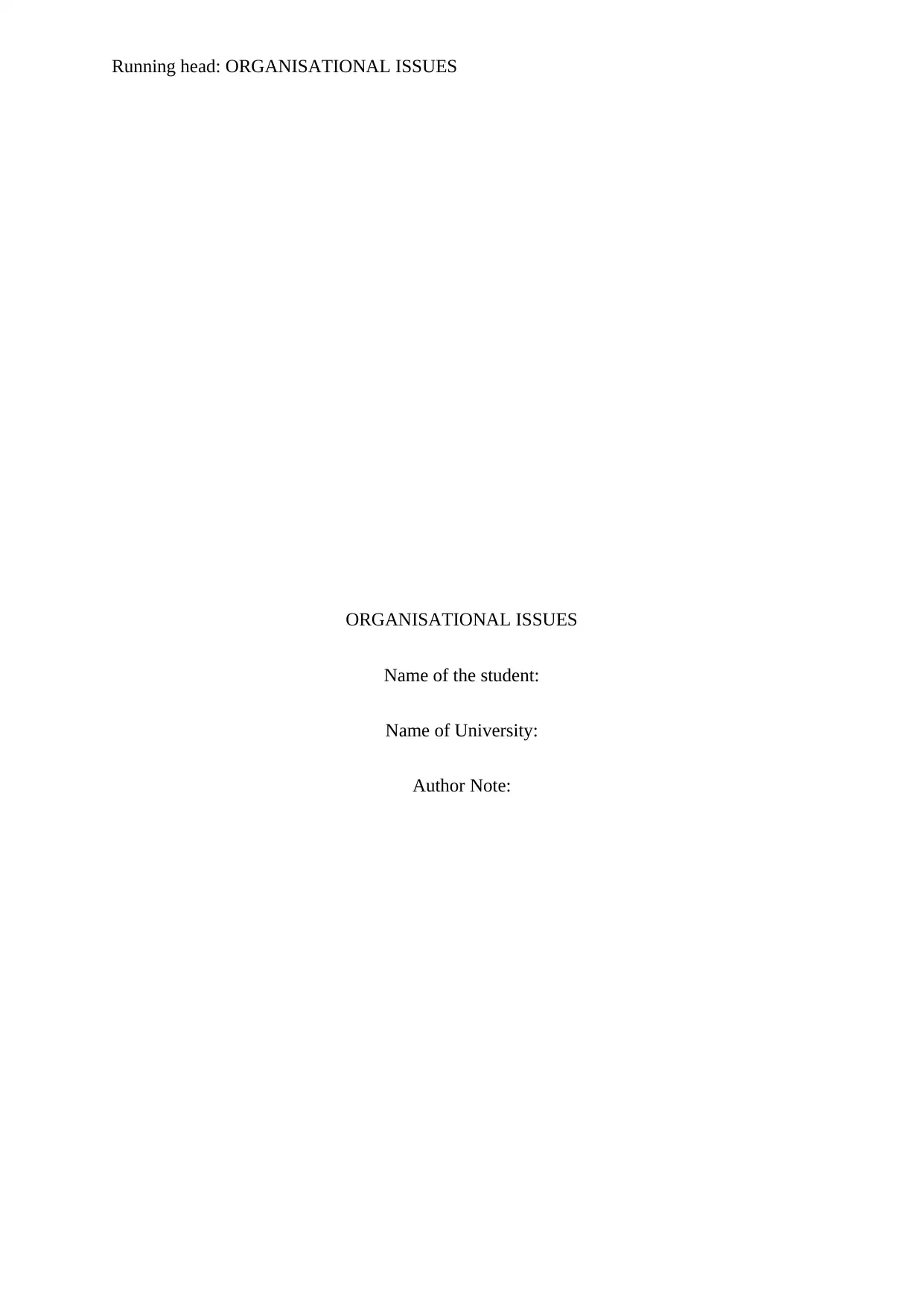
Running head: ORGANISATIONAL ISSUES
ORGANISATIONAL ISSUES
Name of the student:
Name of University:
Author Note:
ORGANISATIONAL ISSUES
Name of the student:
Name of University:
Author Note:
Paraphrase This Document
Need a fresh take? Get an instant paraphrase of this document with our AI Paraphraser
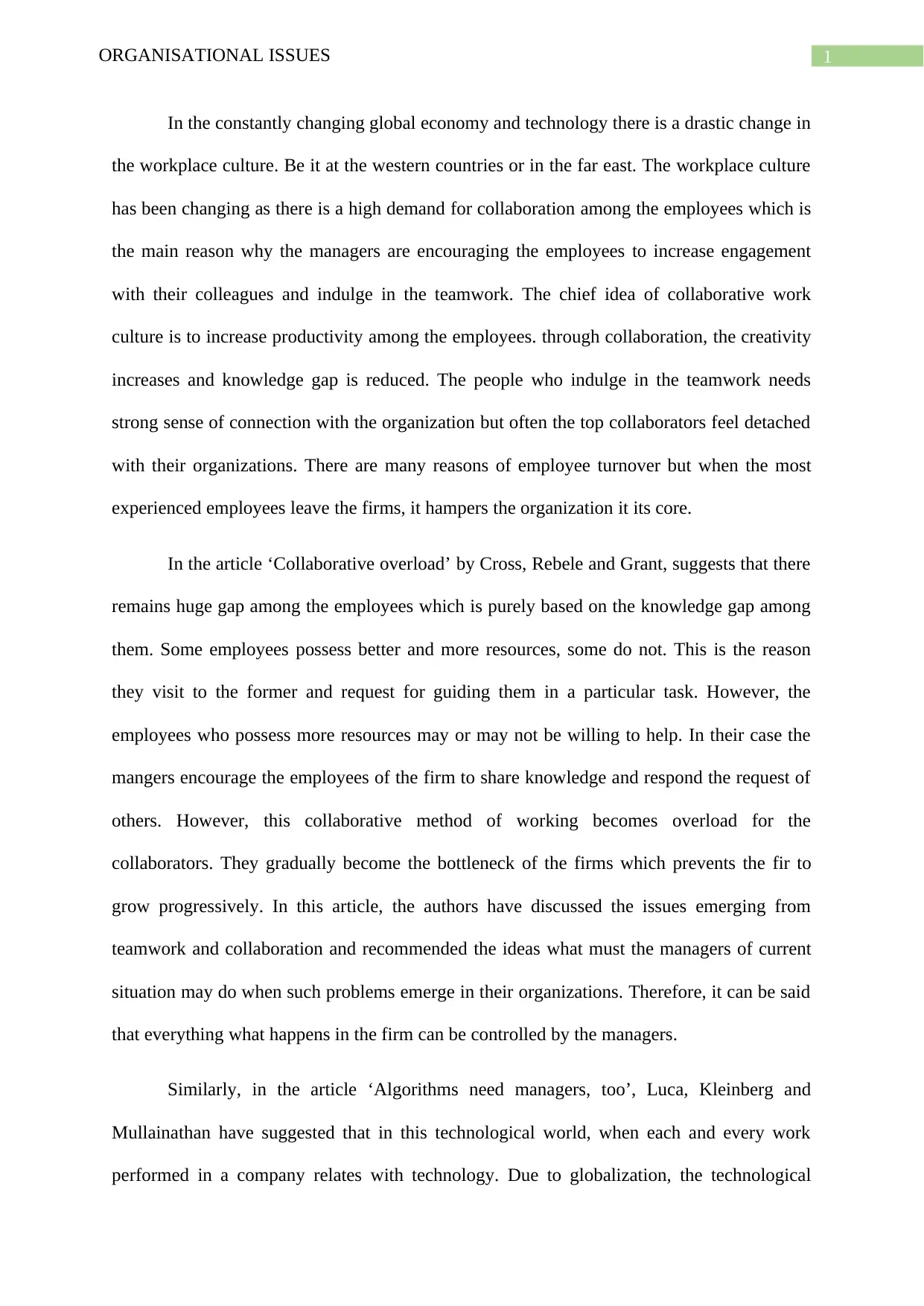
1ORGANISATIONAL ISSUES
In the constantly changing global economy and technology there is a drastic change in
the workplace culture. Be it at the western countries or in the far east. The workplace culture
has been changing as there is a high demand for collaboration among the employees which is
the main reason why the managers are encouraging the employees to increase engagement
with their colleagues and indulge in the teamwork. The chief idea of collaborative work
culture is to increase productivity among the employees. through collaboration, the creativity
increases and knowledge gap is reduced. The people who indulge in the teamwork needs
strong sense of connection with the organization but often the top collaborators feel detached
with their organizations. There are many reasons of employee turnover but when the most
experienced employees leave the firms, it hampers the organization it its core.
In the article ‘Collaborative overload’ by Cross, Rebele and Grant, suggests that there
remains huge gap among the employees which is purely based on the knowledge gap among
them. Some employees possess better and more resources, some do not. This is the reason
they visit to the former and request for guiding them in a particular task. However, the
employees who possess more resources may or may not be willing to help. In their case the
mangers encourage the employees of the firm to share knowledge and respond the request of
others. However, this collaborative method of working becomes overload for the
collaborators. They gradually become the bottleneck of the firms which prevents the fir to
grow progressively. In this article, the authors have discussed the issues emerging from
teamwork and collaboration and recommended the ideas what must the managers of current
situation may do when such problems emerge in their organizations. Therefore, it can be said
that everything what happens in the firm can be controlled by the managers.
Similarly, in the article ‘Algorithms need managers, too’, Luca, Kleinberg and
Mullainathan have suggested that in this technological world, when each and every work
performed in a company relates with technology. Due to globalization, the technological
In the constantly changing global economy and technology there is a drastic change in
the workplace culture. Be it at the western countries or in the far east. The workplace culture
has been changing as there is a high demand for collaboration among the employees which is
the main reason why the managers are encouraging the employees to increase engagement
with their colleagues and indulge in the teamwork. The chief idea of collaborative work
culture is to increase productivity among the employees. through collaboration, the creativity
increases and knowledge gap is reduced. The people who indulge in the teamwork needs
strong sense of connection with the organization but often the top collaborators feel detached
with their organizations. There are many reasons of employee turnover but when the most
experienced employees leave the firms, it hampers the organization it its core.
In the article ‘Collaborative overload’ by Cross, Rebele and Grant, suggests that there
remains huge gap among the employees which is purely based on the knowledge gap among
them. Some employees possess better and more resources, some do not. This is the reason
they visit to the former and request for guiding them in a particular task. However, the
employees who possess more resources may or may not be willing to help. In their case the
mangers encourage the employees of the firm to share knowledge and respond the request of
others. However, this collaborative method of working becomes overload for the
collaborators. They gradually become the bottleneck of the firms which prevents the fir to
grow progressively. In this article, the authors have discussed the issues emerging from
teamwork and collaboration and recommended the ideas what must the managers of current
situation may do when such problems emerge in their organizations. Therefore, it can be said
that everything what happens in the firm can be controlled by the managers.
Similarly, in the article ‘Algorithms need managers, too’, Luca, Kleinberg and
Mullainathan have suggested that in this technological world, when each and every work
performed in a company relates with technology. Due to globalization, the technological
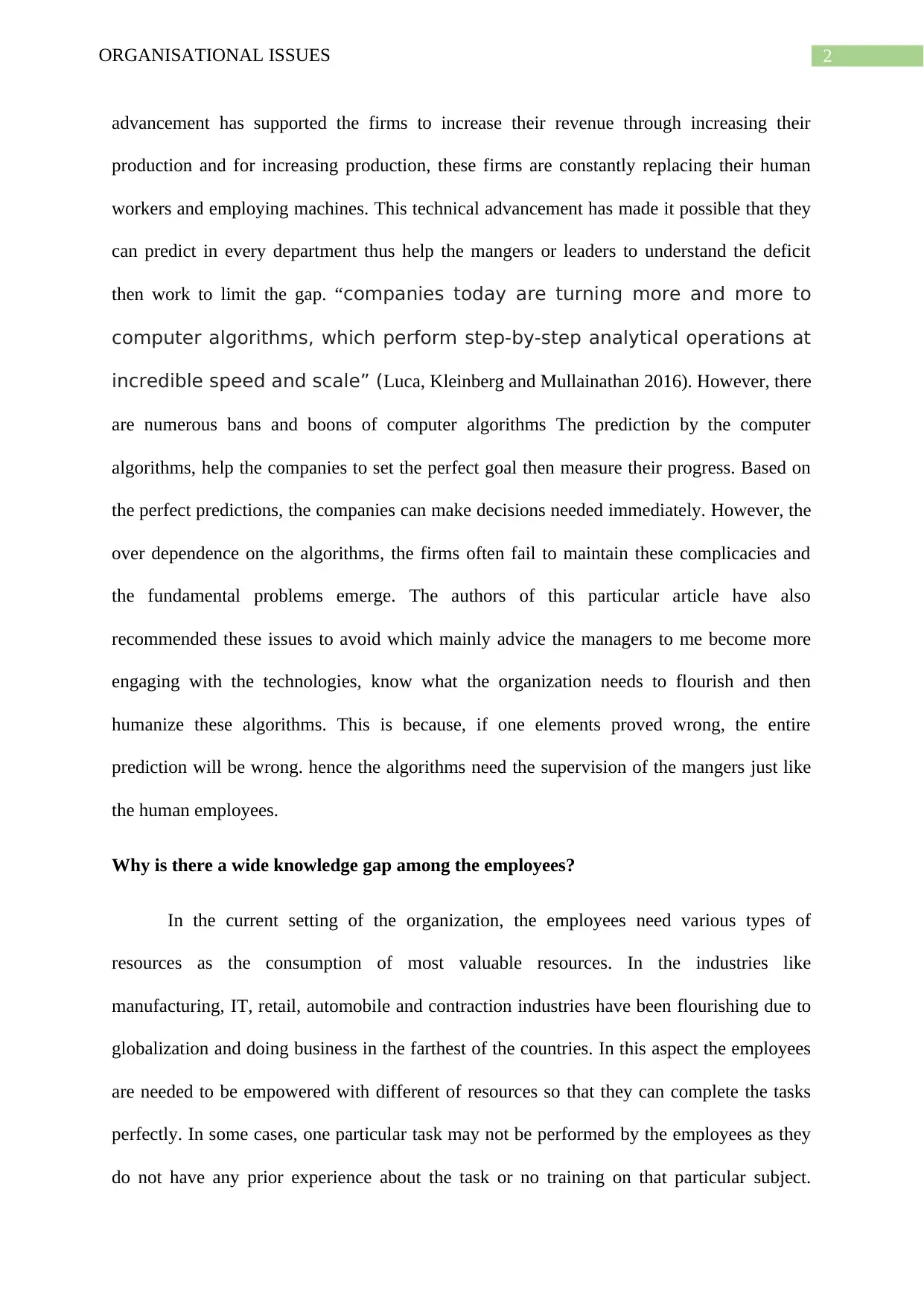
2ORGANISATIONAL ISSUES
advancement has supported the firms to increase their revenue through increasing their
production and for increasing production, these firms are constantly replacing their human
workers and employing machines. This technical advancement has made it possible that they
can predict in every department thus help the mangers or leaders to understand the deficit
then work to limit the gap. “companies today are turning more and more to
computer algorithms, which perform step-by-step analytical operations at
incredible speed and scale” (Luca, Kleinberg and Mullainathan 2016). However, there
are numerous bans and boons of computer algorithms The prediction by the computer
algorithms, help the companies to set the perfect goal then measure their progress. Based on
the perfect predictions, the companies can make decisions needed immediately. However, the
over dependence on the algorithms, the firms often fail to maintain these complicacies and
the fundamental problems emerge. The authors of this particular article have also
recommended these issues to avoid which mainly advice the managers to me become more
engaging with the technologies, know what the organization needs to flourish and then
humanize these algorithms. This is because, if one elements proved wrong, the entire
prediction will be wrong. hence the algorithms need the supervision of the mangers just like
the human employees.
Why is there a wide knowledge gap among the employees?
In the current setting of the organization, the employees need various types of
resources as the consumption of most valuable resources. In the industries like
manufacturing, IT, retail, automobile and contraction industries have been flourishing due to
globalization and doing business in the farthest of the countries. In this aspect the employees
are needed to be empowered with different of resources so that they can complete the tasks
perfectly. In some cases, one particular task may not be performed by the employees as they
do not have any prior experience about the task or no training on that particular subject.
advancement has supported the firms to increase their revenue through increasing their
production and for increasing production, these firms are constantly replacing their human
workers and employing machines. This technical advancement has made it possible that they
can predict in every department thus help the mangers or leaders to understand the deficit
then work to limit the gap. “companies today are turning more and more to
computer algorithms, which perform step-by-step analytical operations at
incredible speed and scale” (Luca, Kleinberg and Mullainathan 2016). However, there
are numerous bans and boons of computer algorithms The prediction by the computer
algorithms, help the companies to set the perfect goal then measure their progress. Based on
the perfect predictions, the companies can make decisions needed immediately. However, the
over dependence on the algorithms, the firms often fail to maintain these complicacies and
the fundamental problems emerge. The authors of this particular article have also
recommended these issues to avoid which mainly advice the managers to me become more
engaging with the technologies, know what the organization needs to flourish and then
humanize these algorithms. This is because, if one elements proved wrong, the entire
prediction will be wrong. hence the algorithms need the supervision of the mangers just like
the human employees.
Why is there a wide knowledge gap among the employees?
In the current setting of the organization, the employees need various types of
resources as the consumption of most valuable resources. In the industries like
manufacturing, IT, retail, automobile and contraction industries have been flourishing due to
globalization and doing business in the farthest of the countries. In this aspect the employees
are needed to be empowered with different of resources so that they can complete the tasks
perfectly. In some cases, one particular task may not be performed by the employees as they
do not have any prior experience about the task or no training on that particular subject.
⊘ This is a preview!⊘
Do you want full access?
Subscribe today to unlock all pages.

Trusted by 1+ million students worldwide
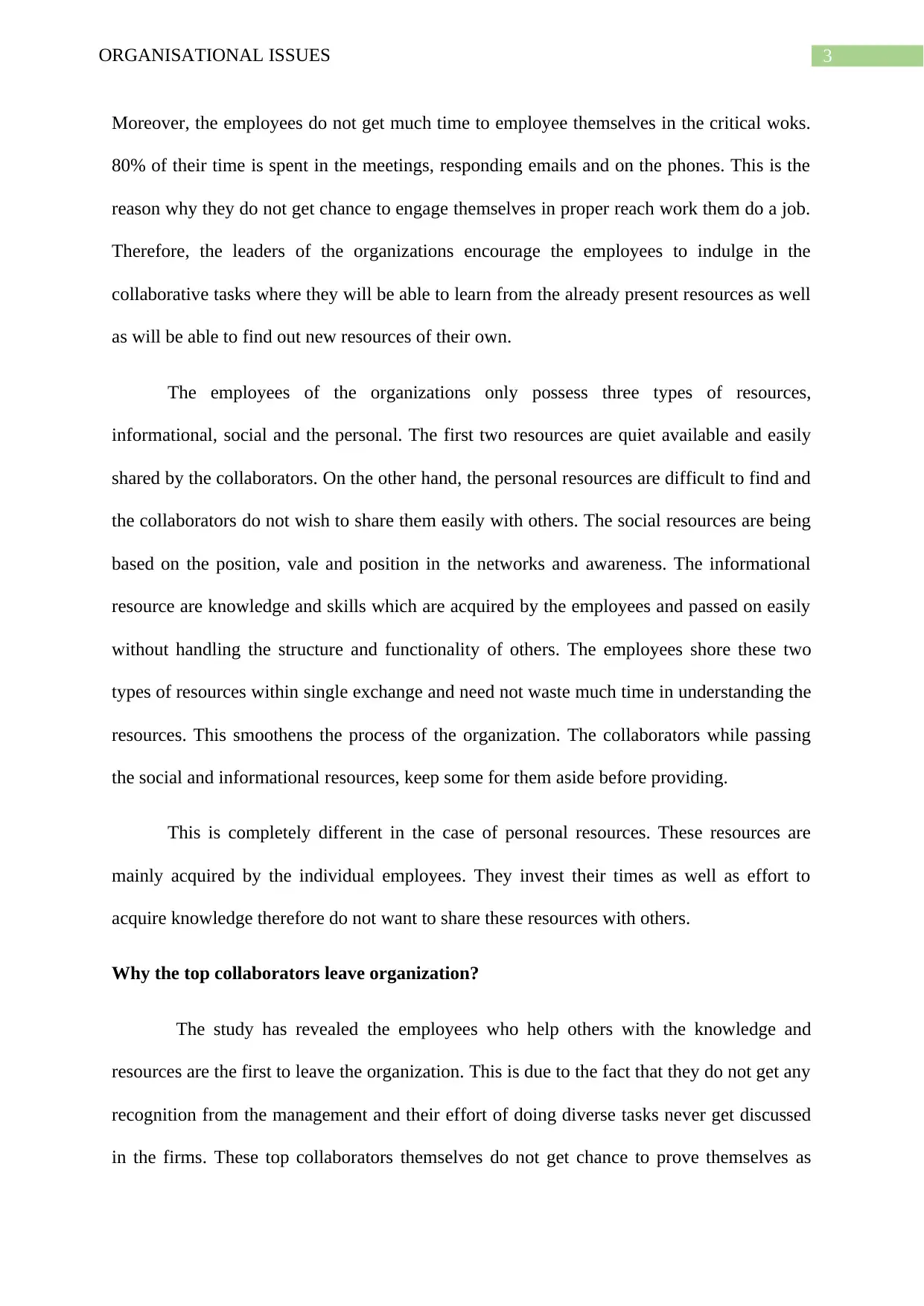
3ORGANISATIONAL ISSUES
Moreover, the employees do not get much time to employee themselves in the critical woks.
80% of their time is spent in the meetings, responding emails and on the phones. This is the
reason why they do not get chance to engage themselves in proper reach work them do a job.
Therefore, the leaders of the organizations encourage the employees to indulge in the
collaborative tasks where they will be able to learn from the already present resources as well
as will be able to find out new resources of their own.
The employees of the organizations only possess three types of resources,
informational, social and the personal. The first two resources are quiet available and easily
shared by the collaborators. On the other hand, the personal resources are difficult to find and
the collaborators do not wish to share them easily with others. The social resources are being
based on the position, vale and position in the networks and awareness. The informational
resource are knowledge and skills which are acquired by the employees and passed on easily
without handling the structure and functionality of others. The employees shore these two
types of resources within single exchange and need not waste much time in understanding the
resources. This smoothens the process of the organization. The collaborators while passing
the social and informational resources, keep some for them aside before providing.
This is completely different in the case of personal resources. These resources are
mainly acquired by the individual employees. They invest their times as well as effort to
acquire knowledge therefore do not want to share these resources with others.
Why the top collaborators leave organization?
The study has revealed the employees who help others with the knowledge and
resources are the first to leave the organization. This is due to the fact that they do not get any
recognition from the management and their effort of doing diverse tasks never get discussed
in the firms. These top collaborators themselves do not get chance to prove themselves as
Moreover, the employees do not get much time to employee themselves in the critical woks.
80% of their time is spent in the meetings, responding emails and on the phones. This is the
reason why they do not get chance to engage themselves in proper reach work them do a job.
Therefore, the leaders of the organizations encourage the employees to indulge in the
collaborative tasks where they will be able to learn from the already present resources as well
as will be able to find out new resources of their own.
The employees of the organizations only possess three types of resources,
informational, social and the personal. The first two resources are quiet available and easily
shared by the collaborators. On the other hand, the personal resources are difficult to find and
the collaborators do not wish to share them easily with others. The social resources are being
based on the position, vale and position in the networks and awareness. The informational
resource are knowledge and skills which are acquired by the employees and passed on easily
without handling the structure and functionality of others. The employees shore these two
types of resources within single exchange and need not waste much time in understanding the
resources. This smoothens the process of the organization. The collaborators while passing
the social and informational resources, keep some for them aside before providing.
This is completely different in the case of personal resources. These resources are
mainly acquired by the individual employees. They invest their times as well as effort to
acquire knowledge therefore do not want to share these resources with others.
Why the top collaborators leave organization?
The study has revealed the employees who help others with the knowledge and
resources are the first to leave the organization. This is due to the fact that they do not get any
recognition from the management and their effort of doing diverse tasks never get discussed
in the firms. These top collaborators themselves do not get chance to prove themselves as
Paraphrase This Document
Need a fresh take? Get an instant paraphrase of this document with our AI Paraphraser
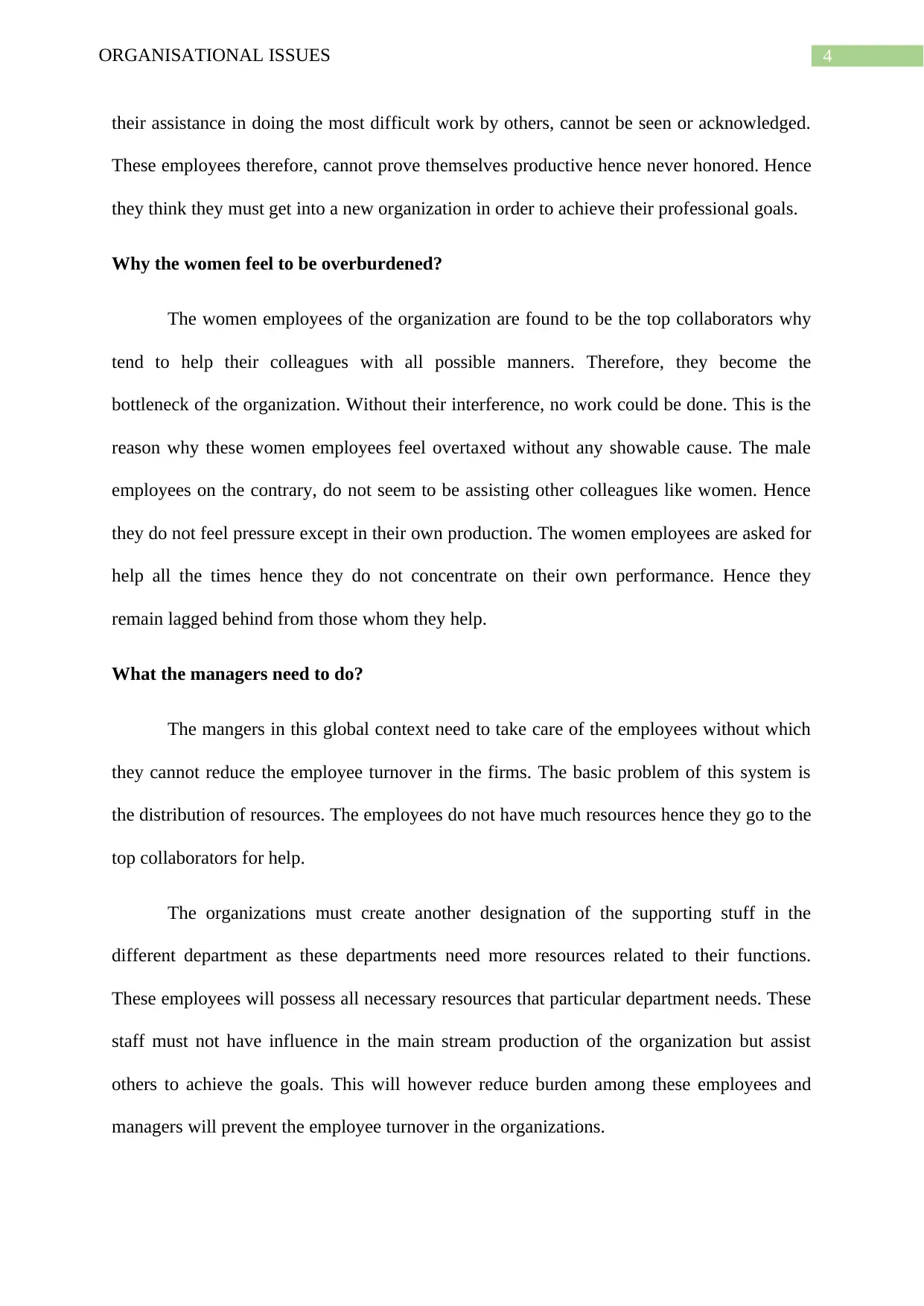
4ORGANISATIONAL ISSUES
their assistance in doing the most difficult work by others, cannot be seen or acknowledged.
These employees therefore, cannot prove themselves productive hence never honored. Hence
they think they must get into a new organization in order to achieve their professional goals.
Why the women feel to be overburdened?
The women employees of the organization are found to be the top collaborators why
tend to help their colleagues with all possible manners. Therefore, they become the
bottleneck of the organization. Without their interference, no work could be done. This is the
reason why these women employees feel overtaxed without any showable cause. The male
employees on the contrary, do not seem to be assisting other colleagues like women. Hence
they do not feel pressure except in their own production. The women employees are asked for
help all the times hence they do not concentrate on their own performance. Hence they
remain lagged behind from those whom they help.
What the managers need to do?
The mangers in this global context need to take care of the employees without which
they cannot reduce the employee turnover in the firms. The basic problem of this system is
the distribution of resources. The employees do not have much resources hence they go to the
top collaborators for help.
The organizations must create another designation of the supporting stuff in the
different department as these departments need more resources related to their functions.
These employees will possess all necessary resources that particular department needs. These
staff must not have influence in the main stream production of the organization but assist
others to achieve the goals. This will however reduce burden among these employees and
managers will prevent the employee turnover in the organizations.
their assistance in doing the most difficult work by others, cannot be seen or acknowledged.
These employees therefore, cannot prove themselves productive hence never honored. Hence
they think they must get into a new organization in order to achieve their professional goals.
Why the women feel to be overburdened?
The women employees of the organization are found to be the top collaborators why
tend to help their colleagues with all possible manners. Therefore, they become the
bottleneck of the organization. Without their interference, no work could be done. This is the
reason why these women employees feel overtaxed without any showable cause. The male
employees on the contrary, do not seem to be assisting other colleagues like women. Hence
they do not feel pressure except in their own production. The women employees are asked for
help all the times hence they do not concentrate on their own performance. Hence they
remain lagged behind from those whom they help.
What the managers need to do?
The mangers in this global context need to take care of the employees without which
they cannot reduce the employee turnover in the firms. The basic problem of this system is
the distribution of resources. The employees do not have much resources hence they go to the
top collaborators for help.
The organizations must create another designation of the supporting stuff in the
different department as these departments need more resources related to their functions.
These employees will possess all necessary resources that particular department needs. These
staff must not have influence in the main stream production of the organization but assist
others to achieve the goals. This will however reduce burden among these employees and
managers will prevent the employee turnover in the organizations.
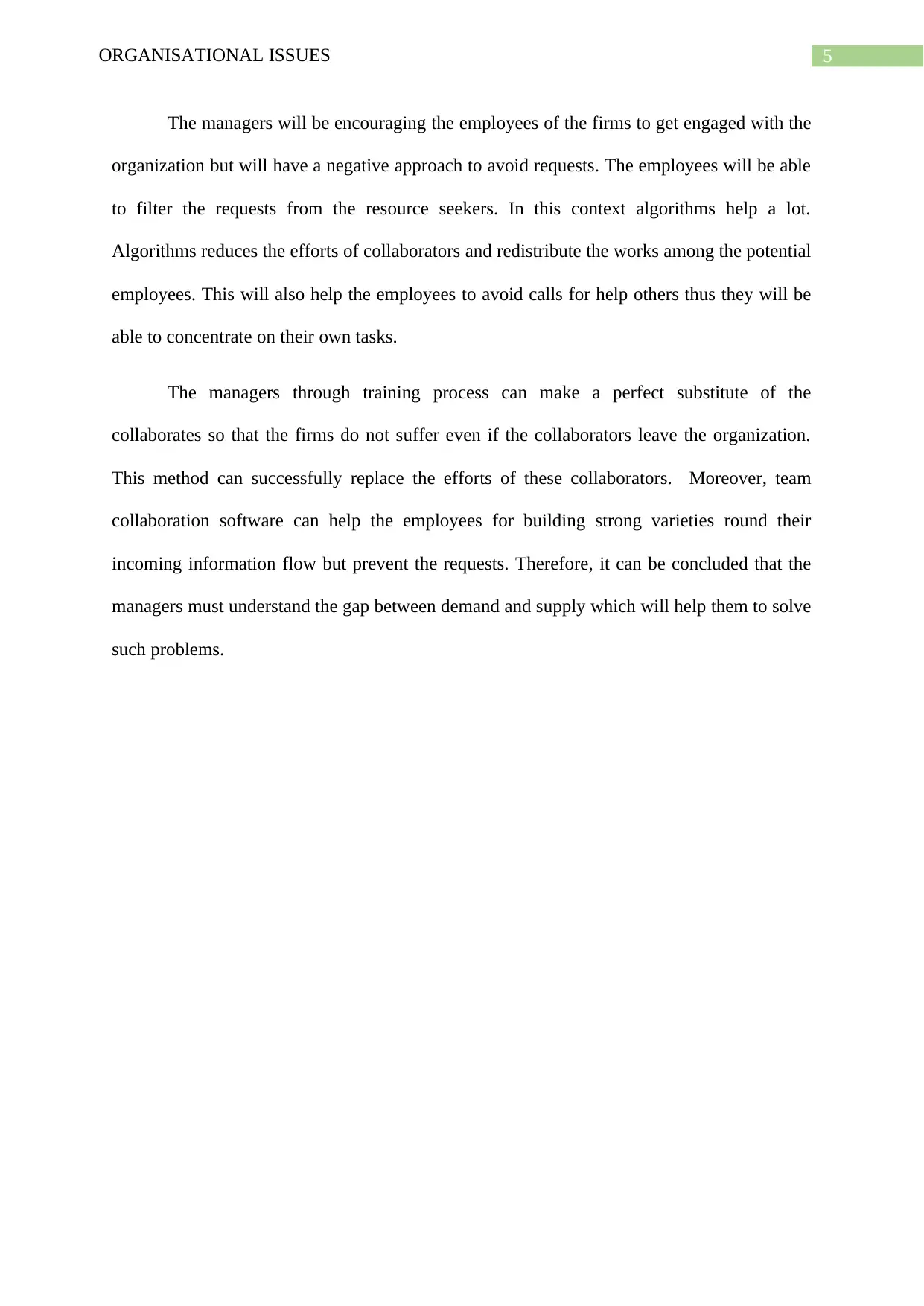
5ORGANISATIONAL ISSUES
The managers will be encouraging the employees of the firms to get engaged with the
organization but will have a negative approach to avoid requests. The employees will be able
to filter the requests from the resource seekers. In this context algorithms help a lot.
Algorithms reduces the efforts of collaborators and redistribute the works among the potential
employees. This will also help the employees to avoid calls for help others thus they will be
able to concentrate on their own tasks.
The managers through training process can make a perfect substitute of the
collaborates so that the firms do not suffer even if the collaborators leave the organization.
This method can successfully replace the efforts of these collaborators. Moreover, team
collaboration software can help the employees for building strong varieties round their
incoming information flow but prevent the requests. Therefore, it can be concluded that the
managers must understand the gap between demand and supply which will help them to solve
such problems.
The managers will be encouraging the employees of the firms to get engaged with the
organization but will have a negative approach to avoid requests. The employees will be able
to filter the requests from the resource seekers. In this context algorithms help a lot.
Algorithms reduces the efforts of collaborators and redistribute the works among the potential
employees. This will also help the employees to avoid calls for help others thus they will be
able to concentrate on their own tasks.
The managers through training process can make a perfect substitute of the
collaborates so that the firms do not suffer even if the collaborators leave the organization.
This method can successfully replace the efforts of these collaborators. Moreover, team
collaboration software can help the employees for building strong varieties round their
incoming information flow but prevent the requests. Therefore, it can be concluded that the
managers must understand the gap between demand and supply which will help them to solve
such problems.
⊘ This is a preview!⊘
Do you want full access?
Subscribe today to unlock all pages.

Trusted by 1+ million students worldwide
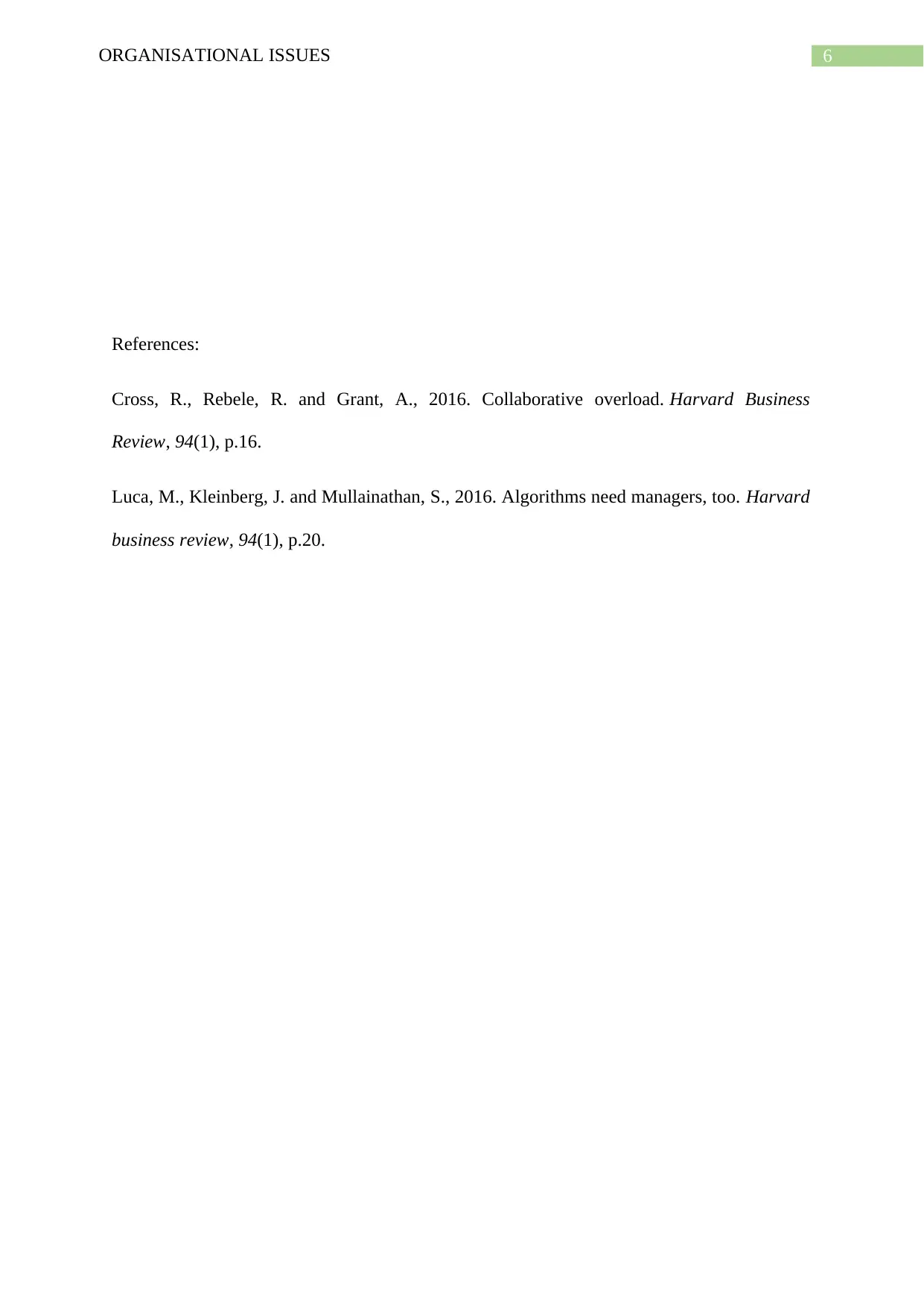
6ORGANISATIONAL ISSUES
References:
Cross, R., Rebele, R. and Grant, A., 2016. Collaborative overload. Harvard Business
Review, 94(1), p.16.
Luca, M., Kleinberg, J. and Mullainathan, S., 2016. Algorithms need managers, too. Harvard
business review, 94(1), p.20.
References:
Cross, R., Rebele, R. and Grant, A., 2016. Collaborative overload. Harvard Business
Review, 94(1), p.16.
Luca, M., Kleinberg, J. and Mullainathan, S., 2016. Algorithms need managers, too. Harvard
business review, 94(1), p.20.
1 out of 7
Your All-in-One AI-Powered Toolkit for Academic Success.
+13062052269
info@desklib.com
Available 24*7 on WhatsApp / Email
![[object Object]](/_next/static/media/star-bottom.7253800d.svg)
Unlock your academic potential
Copyright © 2020–2025 A2Z Services. All Rights Reserved. Developed and managed by ZUCOL.


